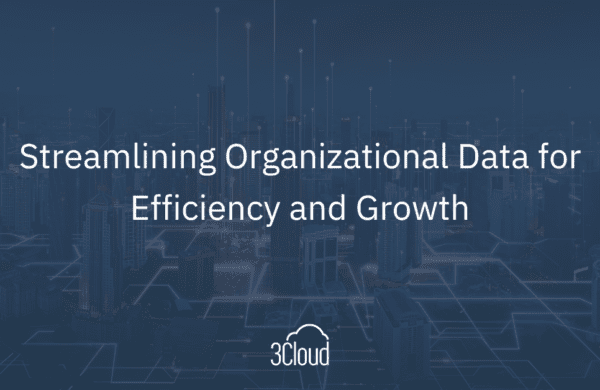How is it that industry leaders like Blockbuster, Eastman Kodak, and Digital Equipment meet their ultimate demise at the hands of competitors that were once a mere glimpse in their rearview mirror?
Today, it’s more clear than ever that companies must innovate to stay on top. Lucky for us, data and technology provide the perfect medium for companies to innovate.
Why do great companies fail?
There are many reasons why great companies fail, but most can be summarized by their failure to innovate. As corporations grow in size, they are less adaptive by nature and take fewer chances on unsuspecting products or small markets. Unfortunately, their seemingly nonthreatening competitors will take full advantage of these passed over opportunities and grow them into large profits. By the time these corporations realize the product or market is now big enough to interest them, it’s too late. Because of this, senior leadership now makes innovation a top priority.
Innovation is by no means easy to accomplish, especially for large corporations. Corporations are typically filled with bureaucracy, arrogance, short-term investment strategies, and inadequate skills. On top of that, let’s face it, it’s pretty hard to come up with the next best thing, right?
What are companies to do?
Business process innovation through data and technology is a form of innovation that is much more tangible than your general product innovation. It is achieved through the culmination of what I call, “The Four Pillars of Data Innovation” which include: Internal and External Data, Technology Platforms, Highly Skilled Technical Individuals, and Business Visionaries. When done correctly, companies have the ability to maximize profits, recognize hidden opportunities, and to stay competitive.
The Four Pillars of Data Innovation
Internal and External Data
Internal data is at the forefront of all companies, big or small. Computer applications that assist in CRM, ERP, Finance, Accounting, Web, and Marketing are generating this data in large quantiles.
External Data is often overlooked and greatly undervalued despite its high availability, increasing accuracy, and relatively low cost to obtain. Marketers are very familiar with lists of consumers and businesses and the myriad of attributes of which they can filter to accurately target their audience. Examples of underutilized external data sets include Currency Rates, Oil Prices, Commodity Futures, and more.
Technology Platforms
Primary Technology Platforms are those software applications mentioned above. Unfortunately, they are too often implemented as “closed systems”. These platforms need to become more dynamic and integrated. Secondary technology platforms are those that include the software applications used to: extract, transform, load, store, report, analyze, and even act on internal and external data. For the purpose of this article, I will group and refer to these as a “Business Intelligence Platform”.
First thing’s first, Business Intelligence Platforms are built, not bought. There are many great offerings on the market today specializing in particular areas. Once the various components are selected, the hard part of building the platform around the organization’s business processes and needs begins.
Highly Skilled Technical Individuals
In order to make use of internal and external data and build a Business Intelligence Platform, you need a team of highly skill technical individuals. These guys are a special breed; they tend to come from a background of business analysis or software development. Regardless of where they came from, they have strong business intuition, unrivaled technical skills, and great problem solving capabilities. Unfortunately, attracting this type of talent is easier said than done as they are in short supply. It’s crucial for organizations to have an ongoing effort to obtain, develop, and keep these individuals when they find them.
Business Visionaries
Business visionaries are crucial to Innovating with data and technology. They tend to have many years of industry experience and a firm understanding of technology. Most importantly, they are creative and tend to work outside-of-the-box. It’s hard to say exactly where to find these guys, but more times than not, they are in a business analysis role or even supporting the technology platforms we just mentioned. When you spot one in your organization, work with them and listen to what they have to say. As crazy as some ideas may seem, with innovation, there are no bad ideas.
“What has happened” vs. “What will happen”
I break Business Process Innovation through Data and Technology into two parts; “What has happened” and “What will happen”.
Let’s start with “What has happened”. This is your basic reporting used by all levels of management from General Sales and P&L to Operational Efficiencies and Customer Satisfaction. There isn’t anything mind-blowing here, but worth noting are a few negative themes among corporations. Inflexibility, inability to slice and dice data, inability to combine data from different data sources, excel workbooks upon excel workbooks, lack of historical data, data quality, and a lack of “one source of truth” are just a few that come to mind. The fact is, most corporation’s analytical capabilities can best be described as a hodgepodge of efforts that have accumulated over the years out of necessity without a clear plan or strategy. When million dollar decisions are being made, it’s critical that the technologies in place are homogenous and data is accurate.
Moving on, let’s talk about “What will happen”. When asking this question, we are basically talking about Predictive Analytics. Companies like Pandora and Netflix have been using Predictive Analytics for years. These innovative companies have created markets off the backs of their Predictive Analytic Engines that consumers value for their ability to make product recommendations. Insurance companies are no stranger to this line of thinking as well. For years, they have been creating risk models to determine the rate to charge individuals based on attributes and behavior of a larger population.
Some uses of Predictive Analytics are not so obvious, particularly, to those outside the world of finance. For example, Predictive Analytics has the potential to provide greater accuracy in forecasts. Being able to better anticipate future prices of raw materials like crude oil or consumer demand has immense value. Managing cash is another example of how Predictive Analytics can be used, especially for global companies dealing with multiple exchange rates.
From a Sales/Operations side, it’s even possible to anticipate when a customer may leave or a sales opportunity might fall out of the pipeline through Text and Interaction Mining on the fly. Real-time pricing models based on supply and demand or peak/non-peak hours is also possible.
Final Thoughts
There are many new products available to help companies innovate from data visualization tools like Tableau to data storage like Microsoft Azure. Companies must realize the ROI of building (or rebuilding) their technology platforms and continue to innovate as the technology around them progresses. Once companies have a solid platform in place that allows them to address “What has happened” they need to start looking into “What will happen”. If all is done correctly, they will soon become a Data-Driven Enterprise and have the ability to not only remain competitive but drive growth.
Want to learn more about how your company can use data and technology to remain competitive and drive growth? We can help. Contact us for a consultation.





